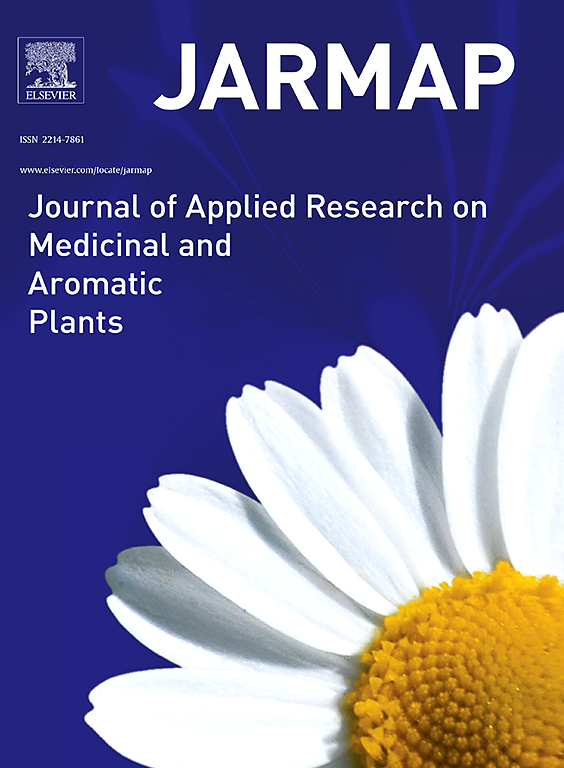微生物群和霉菌毒素分析揭示了 Aesculus wilsonii Rehd 果实标准化储藏的重要性
IF 3.6
2区 农林科学
Q1 PLANT SCIENCES
Journal of Applied Research on Medicinal and Aromatic Plants
Pub Date : 2024-10-05
DOI:10.1016/j.jarmap.2024.100586
引用次数: 0
摘要
Aesculus wilsonii Rehd 是一种药食同源植物,其果实可用于治疗软组织水肿和渗出等疾病。然而,A. wilsonii 果实中是否存在微生物和霉菌毒素污染物仍不清楚。本研究采用高通量测序和液相色谱仪串联质谱法测定了威尔逊霉果中真菌微生物组的多样性和霉菌毒素的含量。在威尔逊果实中普遍存在的真菌包括镰刀菌、壳斗菌、竹荪和曲霉。此外,霉菌毒素检测显示,所有样本的赭曲霉毒素 A 检测结果均呈阳性,72.4%的样本检测到脱氧雪腐镰刀菌烯醇,24.1%的样本检测到玉米赤霉烯酮,62.1%的样本检测到 T-2 毒素,表明这些霉菌毒素是主要污染物。此外,为了监测产生霉菌毒素的真菌,建立了针对镰刀菌和曲霉毒素生物合成途径中关键基因的多重连接依赖性探针扩增(MLPA)技术,可检测 DNA 含量小于 20 纳克的真菌。总之,本研究报告了威尔逊(A. wilsonii)果实中微生物组的多样性和真菌污染的普遍性,同时还建立了一种快速检测致毒真菌的方法。这项工作的重点是分析和检测威尔森果实中的微生物群和真菌毒素,为研究药用产品贮藏过程中潜在的有害微生物提供参考。本文章由计算机程序翻译,如有差异,请以英文原文为准。
Analysis of microbiomes and mycotoxins revealing the importance in the standardized storage of Aesculus wilsonii Rehd fruit
Aesculus wilsonii Rehd, a medicinal food homology plant, whose fruit are used to treat diseases such as edema and exudation of soft tissue. Nonetheless, the presence of microbial and mycotoxin contaminants in A. wilsonii fruit is still unclear. In this study, high-throughput sequencing and liquid chromatograph tandem-mass spectrometry were conducted to determine the diversity of fungal microbiome and mycotoxin contents in moldy A. wilsonii fruit. The prevalent fungi in A. wilsonii fruit included Fusarium, Colletotrichum, Dictyostelium, and Aspergillus. Furthermore, mycotoxin tests showed that all samples tested positive for ochratoxin A, with deoxynivalenol detected in 72.4 % of samples, zearalenone in 24.1 %, and T-2 toxin in 62.1 %, revealing these mycotoxins constituted the primary contaminants. Moreover, to monitor the mycotoxin-producing fungi, multiplex ligation-dependent probe amplification (MLPA) targeting key genes in toxin biosynthetic pathway of Fusarium and Aspergillus was established. and it can detect fungi with DNA content less than 20 ng. In conclusion, this study reported the microbiome diversity and the prevalence of fungi contamination in A. wilsonii fruit, while also established a rapid method for detecting toxigenic fungi. This work focused on analyzing and detecting microbiomes and mycotoxins in A. wilsonii fruit, providing a reference for the study of potentially harmful microorganisms in the storage of medicinal products.
求助全文
通过发布文献求助,成功后即可免费获取论文全文。
去求助
来源期刊

Journal of Applied Research on Medicinal and Aromatic Plants
Pharmacology, Toxicology and Pharmaceutics-Drug Discovery
CiteScore
6.40
自引率
7.70%
发文量
80
审稿时长
41 days
期刊介绍:
JARMAP is a peer reviewed and multidisciplinary communication platform, covering all aspects of the raw material supply chain of medicinal and aromatic plants. JARMAP aims to improve production of tailor made commodities by addressing the various requirements of manufacturers of herbal medicines, herbal teas, seasoning herbs, food and feed supplements and cosmetics. JARMAP covers research on genetic resources, breeding, wild-collection, domestication, propagation, cultivation, phytopathology and plant protection, mechanization, conservation, processing, quality assurance, analytics and economics. JARMAP publishes reviews, original research articles and short communications related to research.
 求助内容:
求助内容: 应助结果提醒方式:
应助结果提醒方式:


